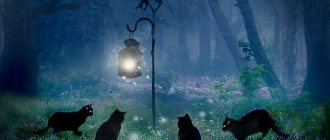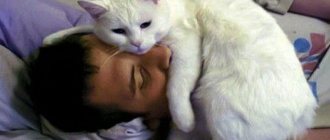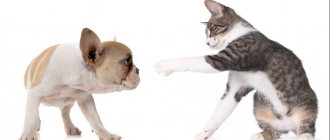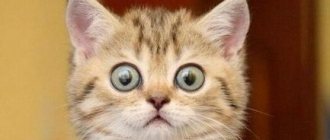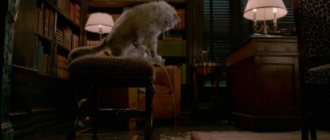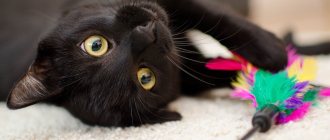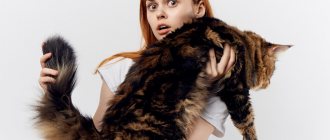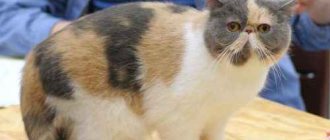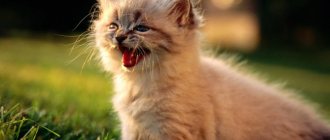They caused the Black Death
The plague overtook Europe during the heyday of religion, so it is not surprising that the epidemic was blamed on the devil and his main intermediaries - cats. A huge number of cats (and snakes, also considered messengers of the devil) were destroyed in a desperate attempt by the church to stop the epidemic. But it only got worse, since the real carrier of the plague turned out to be fleas living on rats and gerbils. As the population of cats and snakes decreased, the number of rodents increased, and the plague began to spread even faster.
Egyptian views
In Ancient Egypt, cats were treated especially reverently. It was believed that the main god of the Egyptian pantheon, Ra, could reside in the cat. His daughter, the goddess Bast (Bastet), who patronized love, beauty, fertility and procreation, was also depicted as a cat or a woman with a cat's head.
Ra also had a guardian cat named Atum. Every night, when the sun god entered the kingdom of the dead in his boat, the ominous serpent Apep stood in his way, wishing that the new day would never come. But Atum killed Apep again and again, and the morning dawn came at the right time.
They roam the Celtic lands
In Scottish and Irish folklore, there is often a large cat called Shea (fairy) who wanders through villages trying to steal the souls of peasants. In fact, according to legend, Shi is a witch who can take the form of a cat, but only nine times. For the last, ninth time, she remains in the cat’s body, so she gets angry, trying to take human souls. However, Shi also has a good side - if during the Samhain holiday you leave a saucer of milk on the doorstep of the house, Shi will thank the owners with protection and good luck. Those who do not leave a treat for the cat will be left without cows.
Myths of the ancient East
Cats are credited with strength and intelligence;
in Tibet
they are called the “eye of heaven.” The cat symbolizes feminine energy - Yin and is endowed with secret power, notes Cat-and-cat.com. The cat's large round eyes glowing in the dark turned her into a mysterious night animal. It is believed that she is able to communicate with otherworldly forces and, thanks to this, can transform and dispel negative energy.
Slavic peoples
They associate the image of the Cat with dark forces, attributing to it lust and laziness. According to Slavic mythology, the Cat is the embodiment of evil spirits.
The image of a cat has its female embodiment and is always associated with witches, which is why everyone is so afraid and does not like black cats.
According to ancient belief, a cat is also associated with the other world, with the world of dreams and visions. According to Slavic mythology, the cat was created from the mitten of the Virgin Mary, it is considered to “carry dreams on its sleeve,” protect small children and drive away all evil spirits. This is why there are so many lullabies about cats.
In Rus', domestic cats appeared only at the beginning of the 11th century, thanks to travelers and sailors.
They quickly won universal love and popularity: the saying “It’s not a hut without a cat” has long appeared. According to current laws, stealing a cat was punishable by a significant fine, several times higher than the fine for stealing a cow. The tricolor cat , according to legend, brought happiness to its owners; they also believed that a black cat in the house saves from thunderstorms and from thieves. Leafing through the good old fairy tales, we see the majestic figure of the Cat Bayun, who sits on a pillar, beats all the people, casts an irresistible sleep and tells fairy tales, and the Cat Kotofeich, who also defeated the Snake and taught people how to make fire.
In Pushkin, the Scientist Cat is not at all so simple: the image of the Oak is a symbol of the World Tree, or the Tree of Life, the golden chain is a symbol of the Paths along which this scientist walks day and night. This is a kind of tamed and ennobled version of the cat Bayun.
The fairy-tale hero, the conqueror of the monster Ivan Popyalov, the hero of the Belarusian fairy tale of the same name, can also turn into a cat. The motif of the hero's transformation into a Cat is also known in the East Slavic cycle of fairy tales about Ivan the Cat's son (more often - Ivan Suchich or Ivan the Peasant Son). In some of these fairy tales, the Cat (along with him, the Cat Kotovich, the brother of Ivan Tsarevich, sometimes appears) can be both the embodiment or assistant of the snake and a snake fighter. Both of these functions are combined in the tale of Volya Volovich, who, after each battle with the snake, encounters “Kotishch, open your eyes,” threatening to eat him. The hero kills the Cat, puts on his skin and, under the guise of the Cat, enters Baba Yaga.
There have long been stories about cats that could transform into people and take on the appearance of beautiful maidens. Aesop's fable "Venus and the Cat" tells the story of a cat who fell in love with a handsome young prince. Venus, the goddess of love, agreed to transform the animal into a charming girl; the young people met and eventually got married. However, the goddess was not sure that the cat’s transformation was complete: on their wedding night, she let a mouse into the couple’s bedroom. Forgetting about everything in the world, the girl rushed at the mouse and devoured it. The goddess, whose suspicions were confirmed, decided that it was better to turn the girl back into a cat.
All superstitions have their origins in myths. There are these types of mythical cats: “demon cat”; "brownie cat"; "destroying cat"; "guide cat"
The cat is a demon
In mythology, a cat acts as the embodiment or assistant of the devil and evil spirits. There is a belief about a special cat devil, an evil spirit from which sorcerers borrow their power. In some cases, the cat acts as a witch. In Slavic folk culture, the result of the action of a black cat most often is illness, damage, the evil eye, and death.
Often in folklore one can find the motif of the transformation of a cat into a person and the reverse transformation of a person into a cat, as well as its consequence - the presence of forms that combine elements of a cat and a person. The elusiveness of the boundaries between feline and human partly helps explain the origin of folklore names like Kot Kotofeich, Kotofey Ivanovich, etc.
The cat is a guide
Often a cat plays the role of a conductor between the human world and the other world. The cat is both a link between worlds and at the same time a victim. It is believed that all animals born blind see the evil spirit. Cats certainly fall into this category. .
Cat - brownie
In Rus', the cat has long been revered as
keeper of the hearth, a symbol of comfort. It is no coincidence that in many countries there was a sign: before entering a new home, you must let the “hostess” - the cat - go ahead of you. She will ensure well-being. A bed was placed where she lay down.
In the Vladimir region, this ritual has long been given another meaning: the one who crosses the threshold of a new house first is the first to die. And since a cat has nine lives, and not one, like a person, it was allowed in first - it will be reborn to life again. The cat is so connected with its owner that it itself can perform some of his duties, namely: play the role of the patron of the house and livestock. Cats are the main guardians of houses. They protect our homes from the invasion of evil, from “uninvited guests” which are very difficult for a person to see.
All cats, regardless of breed, have an amazing ability. They can redistribute and generate negative energy by processing it into lighter energy.
Probably, if you have a pet, then you have noticed that if you are sick, then a friend on all fours is already right there. Cats always sense where their care is needed.
Cat is a destroyer
Cats, which are described in legends, have a special function. The image of a cat in Slavic legends is quite specific - it is a cat-creator and a cat-destroyer. The motifs of the learned cat are common in various tales. Pushkin’s scientist cat, walking “around the chain”, is a cute and harmless creature compared to its folklore prototype - the monstrous Cat Bayun,
Cat Baiyun
Cat Bayun is a character in Russian fairy tales. This cat tells fairy tales while sitting on a pole, but at the same time pretends to be asleep and “beats all the people.” The word “bayun,” according to Dahl’s explanatory dictionary, comes from “bayat” or “bait.” This means “to speak, to tell,” and Bayun himself is, respectively, “a talker and a storyteller.” The image of the cat Bayun combines the features of a fairy-tale monster and a bird with a magical voice. Fairy tales say that Bayun sits on a high iron pillar. He weakens everyone who tries to approach him with the help of songs and spells. The most striking example of the dual nature of a fairy-tale cat is the image of Baba Yaga’s cat from the fairy tale “Baba Yaga”.
The cat is a toy
Another unusual fairy tale character is the toy cat.
from the fairy tale "Little Ivan - Great in Mind." This cat plays the magic harp, and his playing makes everyone who hears it dance against their own will.
Fire earth cat
In the Urals there were legends about
the Earthen Cat
. This huge cat walks underground and guards treasures, and only its fiery ears are visible on the surface. According to legend, wolves are afraid of her fiery ears, but for humans, the Earthen cat does not pose any threat, and can even become an unexpected savior. Cats in Ural and Siberian mythology act as assistants to the Mistress of the Copper Mountain.
The cat is an amazing animal that has lived next to humans for more than five thousand years. This is a proud and independent creature, but sensitive and responsive to kindness. Of course, there are other favorites among people, such as dogs, hamsters or fish, but cats are the most beloved of all domestic animals. These pets live in all corners of our planet, and this is good news. They are very soft, gentle, small fluffy lumps that give a person warmth and affection. They bring out the best feelings in us. People have always believed that they are the ones who get cats, but in fact it's quite the opposite. Since ancient times, cats have always accompanied humans. But at the same time, they never served him like other animals. Living nearby, they maintain complete independence and friendly neutrality. One day, scientists decided to count how many domestic animals live on our planet, and it turned out that there are only 400 million of them, and the largest number of cats live in the United States. And in Indonesia there live 30 million of these cute and wonderful animals, in France there are more than 8 million.
It is precisely because such a huge number of cats and kittens always live and have lived next to people that people come up with various legends, fairy tales, and traditions. Each nation has them differently, each nation sees these cute creatures in its own way.
Therefore, the cat not only entered the mythology of different nations, but also became the hero of many folklore and literary works.
Today, the cat is one of the most beloved pets in many countries. In addition, in some cultures, the cat is a symbol of royalty. In Feng Shui, a cat symbolizes home and comfort. She vigilantly guards family happiness. The cat symbol always helps to get out of difficult situations and helps in the fight against evil. These cute creatures are a traditional amulet for attracting money, good luck and protection to your home or business.
The cat is often found in medieval heraldry. These animals have an understanding of freedom, since the cat does not want to be caught or imprisoned. The cat is not discouraged and cunning... Therefore, endowing cats with a symbol of freedom, the ancient families of the Swabians, Swiss and Burgundians introduced them into their coats of arms in the Middle Ages in France and Switzerland
the cat was depicted on the coats of arms of the most famous and ancient families. The independence and love of freedom of this animal have been worthy of respect in all centuries. The cat is an ardent defender of his territory, he is cheerful and cunning. This is exactly how we see it on the ancient coats of arms of the Swabians.
In France
cats were considered witchcraft animals. White and black cats were endowed with special miraculous properties. In the Middle Ages, the Inquisition declared cats to be tools of the devil. They were burned and drowned along with the “sorcerers.” In general, there are many superstitions associated with cats, and most of them are more naive than absurd. The goddess of fertility, love and beauty, Freya, in Norse mythology, rode in a carriage driven by cats. In China, the cat also symbolized motherhood and the guardian of the harvest.
They believed that if you hang a bunch of cat hair on the door of a young mother’s room, the baby will definitely be happy. In Japan, only a very wealthy, famous person could become the owner of a cat. Keeping an animal required enormous expenses: it was customary to dress up the pet in every possible way, feed it only from gold and silver dishes with specially prepared food, and even assign a personal servant to it. Rich Japanese took very small kittens into their home, who had not yet learned to hunt, so they did not even know how to catch mice. Well, ordinary residents of the Land of the Rising Sun believed that an ordinary image or figurine of an animal would help scare away rodents.
In Islam, the cat also has a special place. She, the only animal, is allowed entry into the mosque and complete freedom of action there. Muslims believe that the cat was born in Noah's Ark from the sneezing of a lion.
According to one of the myths, it all started with the beloved cat of the Prophet Muhammad. Her name was Muezza. The Prophet loved her so much that he never disturbed her sleep, and used the water she drank for ablution before prayer. She also loved to sleep on his lap during sermons. In general, she behaved like any beloved domestic cat. One day, the pussy fell asleep on the sleeve of the master's robe, prepared for morning prayer. Without hesitation, Muhammad cut off the sleeve on which the animal was dozing and got dressed. When Muhammad returned from prayer, Muezza woke up and bowed to the Prophet, and he stroked the cat's back three times. Due to the fact that the hand of the Messenger of Allah touched the back of the animal, cats almost never fall on their back, but land on their paws.
Another myth says that the dark stripes on the animal’s skin are traces of the prophet’s fingers. One day, a cat killed a snake that had climbed into the sleeve and was about to sting Muhammad. Ahead of the Prophet, who was about to put on clothes with death hidden in them, the cat bravely jumped onto the sleeve, bit the snake to death and proudly showed the prey to Muhammad. Was it Muezza? For his salvation, the Prophet touched the cat's forehead and forever left four clear lines on it, marking the blessed animal.
In addition, Muhammad also forbade selling cats for money or exchanging them for goods. This is a free being, not property, the Prophet respectfully believed.
Muhammad's love for cats was shared by his loved ones. Thus, the Prophet’s friend Abd al-Rahman even earned the nickname Abu Huraira, the father of cats, because wherever he went, he had a kitten with him. In addition, being the caretaker of the mosque, he made sure that the surrounding cats were always fed. Because of this, the cat tribe in the mosque itself increased significantly. Cotopapa lived up to his nickname.
And so, since the time of the Prophet, cats have been revered by all Muslims. And they are not just revered! Poems were composed in their honor; the Sufis compared the purring of a cat to the performance of dhikr - the rhythmic repetition of the name of God, which is why mustachioed tabby cats were used in hospitals, believing in the healing power of their purring. Cats were even used as an example to other Muslims.
Sufi legends also tell about the sheikh’s cat, who helped the teachers clean up the school (isn’t that the prototype of Mrs. Norris from Harry Potter?). One day this cat sacrificed himself to save the dervishes. Another sheikh, Abu Bakr al Shibli, after his death, appeared in a dream to one of his students and told him that he had gone to heaven. However, he was not awarded such mercy for his religious zeal. Allah said to him: “Do you remember the cold snowy day in Baghdad, when you were walking, wrapped in a warm cloak, and suddenly you met a freezing kitten. You took it and warmed it under your cloak. Because of this kitten you are forgiven.”
In the 13th century, the Mamluk Sultan of Egypt and Syria, al-Zahir Baybars, ordered the founding of a special “cat garden” where the cats of Cairo could find shelter, food and drink at any time. Since then, this place has changed hands many times, but the Sultan’s decree was strictly carried out, and is still being carried out to this day. Every evening, thousands of Cairo cats flock to the garden, where people come with baskets full of food for them. Whatever changes the new century promises, cats must be fed.
And today, many Islamic cities are overrun with cats, which are groomed, cherished and allowed to go wherever this freedom-loving, but surprisingly affectionate creature decides to go. After all, after death, the cat goes straight to heaven, where he can tell the Prophet about your kindness.
According to Blavatsky, a cat more often than other animals takes the shape of a circle (like a snake coiled into a ring) and is therefore a sacred animal. Symbols and myths about cats and kittens speak of the admiration of these animals by the ancient Greeks and Egyptians, the inhabitants of Tibet and Switzerland. The fact that the image of a cat was used as a symbol of love of freedom and independence allows us to understand what kind of treasure the owner of this amazing animal owns. Listen with your heart to what your cat is trying to tell you, and you will learn a lot of new and interesting things about life, about people and about yourself.
Cats have their own monarchy
According to an old English legend that has been adapted into the folk fable of the Cat King, a peasant once saw nine black cats with white breasts. The cats carried a small coffin with a crown on it. Noticing the farmer, one of the cats said to him in human English: "Tell Tommy Tildrum that Timmy Tildrum is dead." Returning home, the stunned man told his wife about what he had seen. After hearing about Timmy's death, the house cat named Old Tom jumped up from the stove and told his owners that he was now the king of all cats and escaped through the chimney.
Curious scientific facts about cats
About vision features
Different breeds of cats - Siberian, British, Norwegian - have an innate gift of healing. Therefore, doctors advise purchasing four-legged friends for children and adults suffering from chronic illnesses.
Being close to its owner, the fluffy dog does not see a clear picture due to congenital farsightedness.
Interestingly, the vision of wild and domestic cats is quite specific. The animal sees what is happening within a radius of 180 degrees, but it cannot see an object that is too close. An interesting fact is that every single one of the pets is farsighted, so they are not able to clearly see their owner’s face. This visual feature is inherent in nature. Hunting predators can simultaneously observe several objects, and the first thing they will pay attention to is the prey moving horizontally.
A common myth is that cats see well in the dark. However, scientific research shows that in order for a Siberian, British, Scottish or other breed to be able to unsee an object or obtain the necessary information about participants in a night hunt, at least a small glimpse of light is required.
About appearance
A person's fingerprints help identify him or her. But cats are not recognized by their paws, their main identifier is their nose. In addition, cats have a sense of smell that is 14 times stronger than that of humans. They capture the air and recognize in it the smells of objects located several tens of kilometers further. Therefore, owners sometimes do not understand what their pets are smelling, because humans simply do not detect the subtle aroma.
Whiskers are an important tool, without which the furry will not have a complete picture of what is happening and will not be able to survive.
Domestic and wild cats boast a wide variety of colors. This is not only due to selection. The main purpose of patterns on the body is camouflage, allowing you to reliably hide from the enemy and adapt to harsh survival conditions. The main relays of information about the surrounding world are vibrissae, also known as whiskers. At the tips of the hairs there are supersensitive nerve endings, with the help of which the animal seems to touch and smell the object of interest. If such a landmark is cut off, the animal will completely change in behavior. There are cases where disoriented pets died under the paw of the enemy because they could not recognize the danger in time.
About behavior
Facts in numbers: cats spend most of their lives sleeping. The animal can sleep 14-20 hours a day.
The most interesting facts from the life of cats concern their behavior. If the owner of a Siberian, Siamese or British breed notices that his pet has suddenly fallen to the floor and is showing her belly, this funny behavior means that the cat completely trusts its owner. Moreover, when strangers touch an animal’s stomach, it becomes tense and angry. A common case is when a cat stands still and jerks its tail from side to side. This is how the pet makes it clear that at a particular moment he does not know what to do - mischief, eat, walk or sleep. For some owners, a pet with its tail raised and showing its anus seems funny or impudent. But by such behavior the animal shows that it trusts the person and does not expect a trick from him.
They can predict the weather
England has a long tradition of observing cats and the natural phenomena that correspond to their behavior. If a cat digs its claws into furniture, carpet or curtains, it means there is a strong wind. If a cat's pupils are dilated, it means rain. Also, rainy weather should be expected if the cat washes its ears for a long time and often. When a cat sits on the windowsill and looks out the window, it means rain; when she sleeps, hiding all her paws under her, it means cold rain. If a cat sleeps on its back, it means rain. In fact, whatever a cat does in England means rain. In principle, it is not surprising.
Beliefs of the ancient Scandinavians
The Scandinavians believed that cats were constant companions of Freya, the blond goddess of war and love. This beauty moved across the heavenly expanses in a chariot, drawn not by horses, but by a pair of large, furry cats, whose ears were decorated with tassels. According to legend, this tailed pair is the ancestors of modern Norwegian forest cats.
Artist Karl Emil Doppler, 1905
In Iceland, the Yule Cat is also known - a negative character who, as they said, on the Yule holiday (analogous to Christmastide in this country) ate those who did not have wool clothes. It is now believed that Icelandic adults deliberately invented an evil cat to force children to take care of sheep. After all, then sheep wool was the main source of income for the inhabitants of this country!
They live in the sea and cause storms
Superstitious British fishermen throw a small portion of their catch back into the sea to please the cat. According to legend, this cat living in the sea was once a woman who practiced magic. She went sailing with her husband. During the voyage, the husband's comrades decided to drown the witch, because it was unlucky for a woman to be on board. It turned out that the woman was overboard - to even greater misfortune. The witch got angry and caused a storm that sank not only the ship with the sailors who drowned her, but the entire flotilla. Since then, the witch has lived in the sea in the form of a four-eyed cat.
Legends of China
The Chinese have legends about Mao's pet murka, and Li about the forest one. In Chinese, to write the short word “Mao”, you need to draw three characters, each of which has its own meaning: “field”, “grass” and “monster”. And, of course, this is not a random set at all. Cats guarded rice crops and were real formidable monsters in the eyes of rodents. According to one version, Mao’s master was the magician Miau-Kuau, who had the power not only to heal people, but even to resurrect the dead.
The Chinese associated the wild cat Li with the goddess Li Shou. At the moment the gods created the earth, she volunteered to look after this miracle. But the frivolous goddess was much more interested in sleep or games than in fulfilling her duties. Then she decided to “resign”, refusing to speak at the same time, and advised to appoint a person in charge. But, unfortunately, he could not understand the gods, and then Li Shou became the link connecting both.
Cats turn into cacti and like to drink
About a century ago, a curious legend was recorded among the Pueblo and Navajo tribes. People described a "cactus-like" creature in the shape of a cat, green in color and with needles instead of fur. Instead of front paws, this strange creature had blades with which it chopped off cacti. Having cut down exactly eighty cacti, the cat returned to the first log house and drank the enzyme juice of the cactus. After she drank the juice from all the cacti, the drunken cat went to scare the herds of cattle and shepherds.
